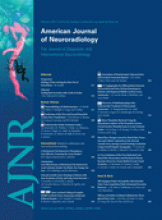Research ArticleBrain
Diagnostic Dilemma of Pseudoprogression in the Treatment of Newly Diagnosed Glioblastomas: The Role of Assessing Relative Cerebral Blood Flow Volume and Oxygen-6-Methylguanine-DNA Methyltransferase Promoter Methylation Status
D.-S. Kong, S.T. Kim, E.-H. Kim, D.H. Lim, W.S. Kim, Y.-L. Suh, J.-I. Lee, K. Park, J.H. Kim and D.-H. Nam
American Journal of Neuroradiology February 2011, 32 (2) 382-387; DOI: https://doi.org/10.3174/ajnr.A2286
D.-S. Kong
S.T. Kim
E.-H. Kim
D.H. Lim
W.S. Kim
Y.-L. Suh
J.-I. Lee
K. Park
J.H. Kim

References
- 1.↵
- Chaskis C,
- Neyns B,
- Michotte A,
- et al
- 2.↵
- Taal W,
- Brandsma D,
- de Bruin HG,
- et al
- 3.↵
- Ichihara E,
- Kiura K,
- Takigawa N,
- et al
- 4.↵
- 5.↵
- Chamberlain MC
- 6.↵
- Brandes AA,
- Tosoni A,
- Spagnolli F,
- et al
- 7.↵
- 8.↵
- Sugahara T,
- Korogi Y,
- Tomiguchi S,
- et al
- 9.↵
- 10.↵
- van den Bent MJ,
- Vogelbaum MA,
- Wen PY,
- et al
- 11.↵
- Macdonald DR,
- Cascino TL,
- Schold SC Jr.,
- et al
- 12.↵
- Hegi ME,
- Diserens AC,
- Gorlia T,
- et al
- 13.↵
- Hegi ME,
- Liu L,
- Herman JG,
- et al
- 14.↵
- Brandes AA,
- Franceschi E,
- Tosoni A,
- et al
- 15.↵
- Brandsma D,
- Stalpers L,
- Taal W,
- et al
- 16.↵
- Palmisano WA,
- Divine KK,
- Saccomanno G,
- et al
- 17.↵
- Herman JG,
- Graff JR,
- Myohanen S,
- et al
- 18.↵
- Ruben JD,
- Dally M,
- Bailey M,
- et al
- 19.↵
- Hu LS,
- Baxter LC,
- Smith KA,
- et al
- 20.↵
- Cha S,
- Knopp EA,
- Johnson G,
- et al
- 21.↵
- Cha S,
- Lupo JM,
- Chen MH,
- et al
- 22.↵
- Chao ST,
- Suh JH,
- Raja S,
- et al
- 23.↵
- Schlemmer HP,
- Bachert P,
- Henze M,
- et al
- 24.↵
- Samnick S,
- Bader JB,
- Hellwig D,
- et al
- 25.↵
- Tsuyuguchi N,
- Sunada I,
- Iwai Y,
- et al
- 26.↵
- Tsuyuguchi N,
- Takami T,
- Sunada I,
- et al
- 27.↵
- Covarrubias DJ,
- Rosen BR,
- Lev MH
In this issue
Advertisement
D.-S. Kong, S.T. Kim, E.-H. Kim, D.H. Lim, W.S. Kim, Y.-L. Suh, J.-I. Lee, K. Park, J.H. Kim, D.-H. Nam
Diagnostic Dilemma of Pseudoprogression in the Treatment of Newly Diagnosed Glioblastomas: The Role of Assessing Relative Cerebral Blood Flow Volume and Oxygen-6-Methylguanine-DNA Methyltransferase Promoter Methylation Status
American Journal of Neuroradiology Feb 2011, 32 (2) 382-387; DOI: 10.3174/ajnr.A2286
0 Responses
Diagnostic Dilemma of Pseudoprogression in the Treatment of Newly Diagnosed Glioblastomas: The Role of Assessing Relative Cerebral Blood Flow Volume and Oxygen-6-Methylguanine-DNA Methyltransferase Promoter Methylation Status
D.-S. Kong, S.T. Kim, E.-H. Kim, D.H. Lim, W.S. Kim, Y.-L. Suh, J.-I. Lee, K. Park, J.H. Kim, D.-H. Nam
American Journal of Neuroradiology Feb 2011, 32 (2) 382-387; DOI: 10.3174/ajnr.A2286
Jump to section
Related Articles
- No related articles found.
Cited By...
- Advanced Distance-Resolved Evaluation of the Perienhancing Tumor Areas with FLAIR Hyperintensity Indicates Different ADC Profiles by MGMT Promoter Methylation Status in Glioblastoma
- Application of 7T MRS to High-Grade Gliomas
- Diagnosis of Pseudoprogression Following Lomustine-Temozolomide Chemoradiation in Newly Diagnosed Glioblastoma Patients Using FET-PET
- MGMT Promoter Methylation Status in Initial and Recurrent Glioblastoma: Correlation Study with DWI and DSC PWI Features
- Vessel Type Determined by Vessel Architectural Imaging Improves Differentiation between Early Tumor Progression and Pseudoprogression in Glioblastoma
- Radiogenomics-based Risk Prediction of Glioblastoma Multiforme with Clinical Relevance
- Moving Toward a Consensus DSC-MRI Protocol: Validation of a Low-Flip Angle Single-Dose Option as a Reference Standard for Brain Tumors
- Multisite Concordance of DSC-MRI Analysis for Brain Tumors: Results of a National Cancer Institute Quantitative Imaging Network Collaborative Project
- MR Imaging-Based Analysis of Glioblastoma Multiforme: Estimation of IDH1 Mutation Status
- Differentiating Tumor Progression from Pseudoprogression in Patients with Glioblastomas Using Diffusion Tensor Imaging and Dynamic Susceptibility Contrast MRI
- ASFNR Recommendations for Clinical Performance of MR Dynamic Susceptibility Contrast Perfusion Imaging of the Brain
- Diffusion and Perfusion MRI to Differentiate Treatment-Related Changes Including Pseudoprogression from Recurrent Tumors in High-Grade Gliomas with Histopathologic Evidence
- Differentiation of Tumor Progression from Pseudoprogression in Patients with Posttreatment Glioblastoma Using Multiparametric Histogram Analysis
- Does MR Perfusion Imaging Impact Management Decisions for Patients with Brain Tumors? A Prospective Study
This article has not yet been cited by articles in journals that are participating in Crossref Cited-by Linking.
More in this TOC Section
Similar Articles
Advertisement











